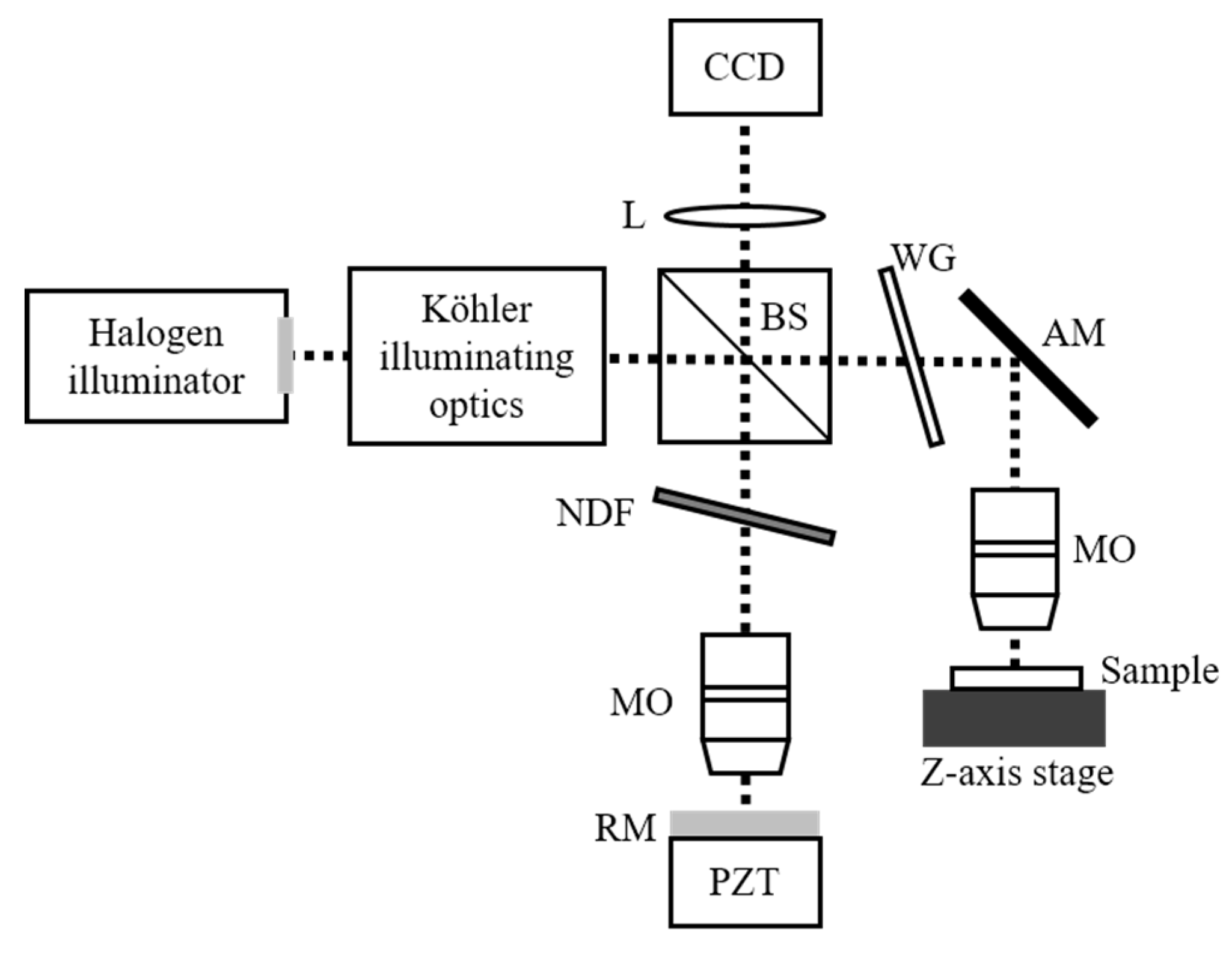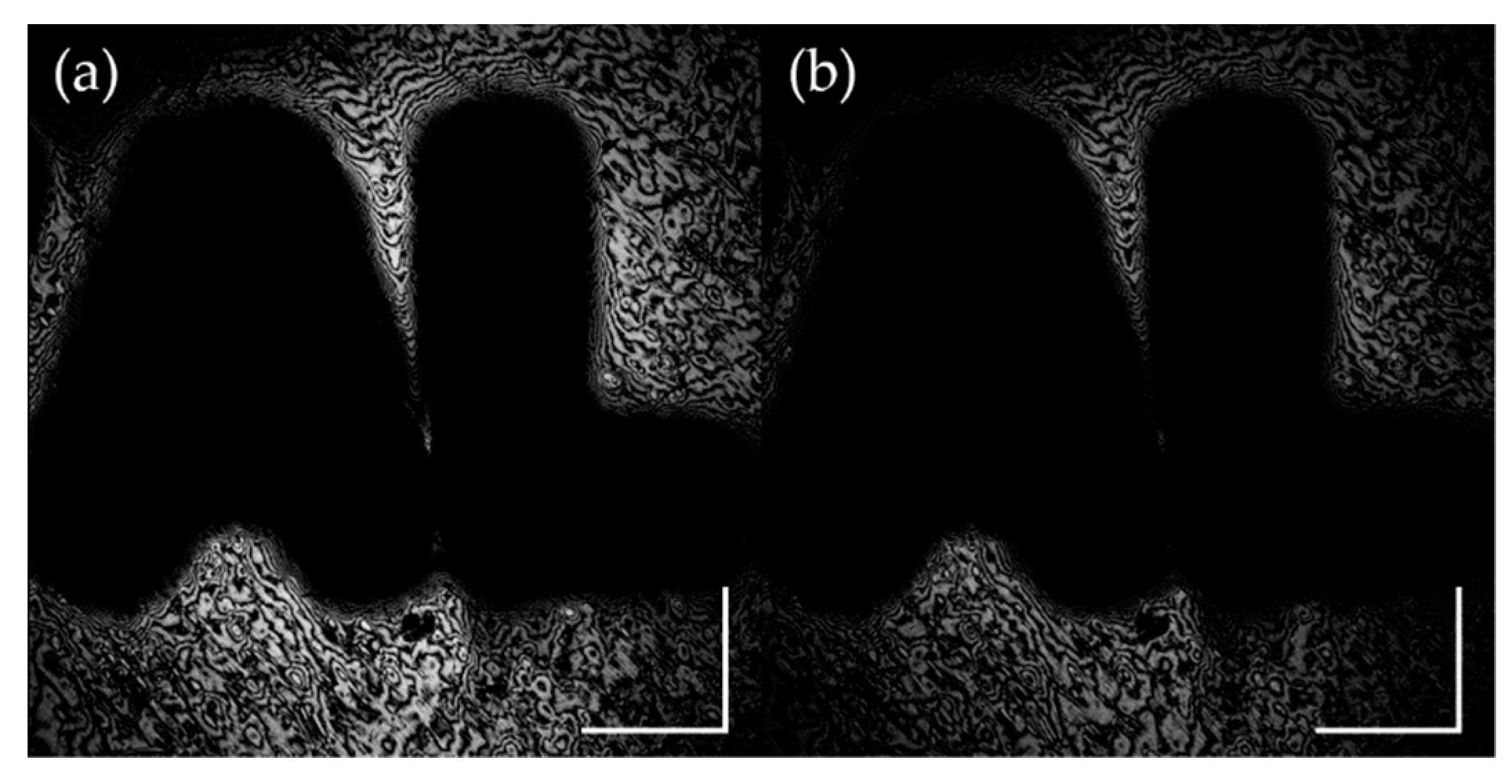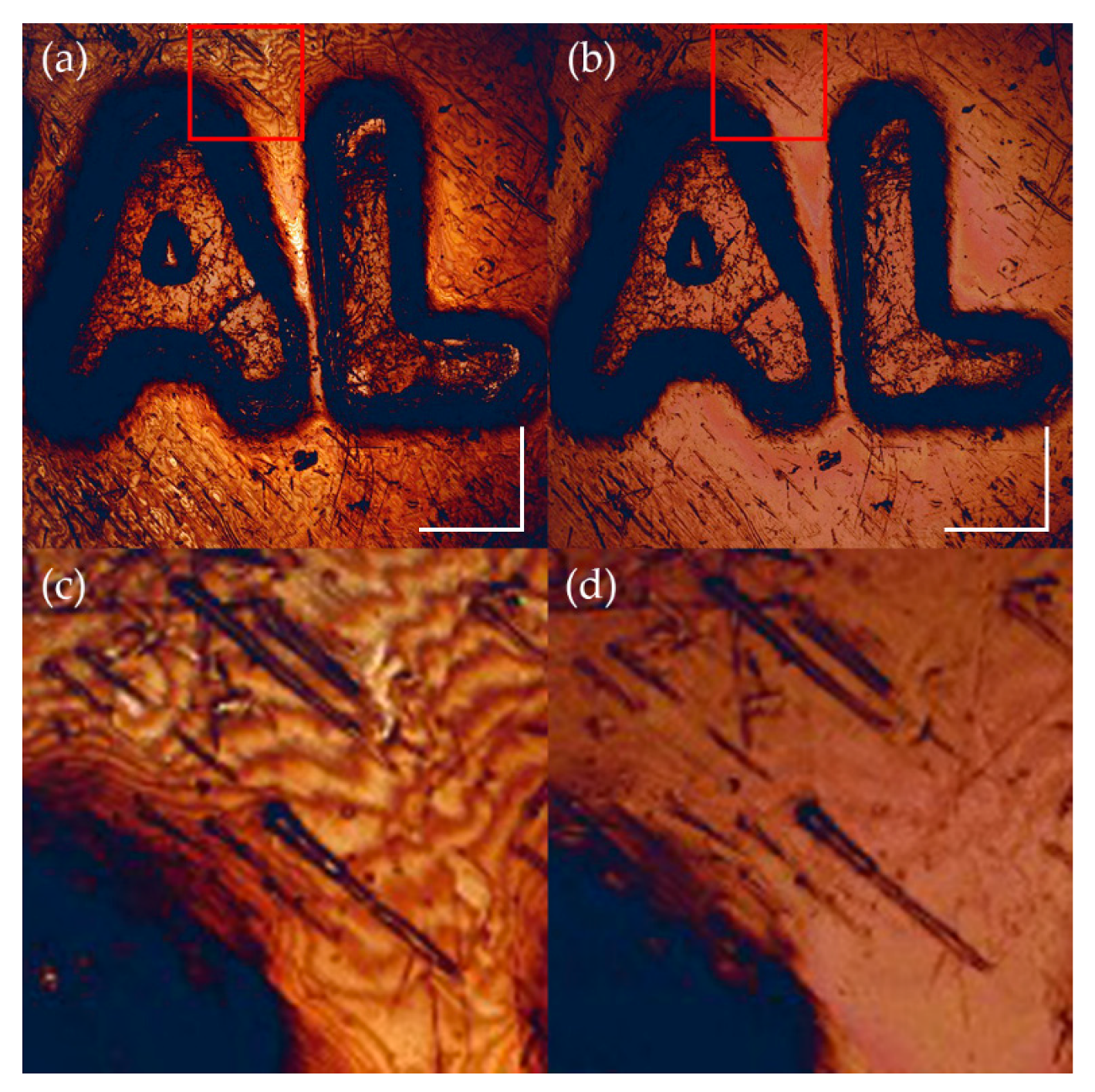1. Introduction
Full-field optical coherence tomography (FF-OCT) is composed of a Michelson interferometer with a full-field illumination. In general, an FF-OCT system has a high axial resolution, owing to the use of a broadband illumination source, and a high lateral resolution, through the application of a high numerical aperture lens [
1]. The system can be used to obtain an en face tomographic image from a two-dimensional detector array without any transverse scanning [
2], and has been applied to various biomedical fields including ex vivo diagnosis of brain tumors [
3], in vivo imaging of human skin [
4], and even in vitro cellular-level imaging of rat eyes [
5]. Its fields of application are also expanding into semiconductor wafers and display panel inspections [
6,
7].
To acquire en face images using an FF-OCT system, a reconstruction process is essential, and numerous reconstruction methods have been proposed. An en face image was reconstructed from a two-dimensional interferogram using a Hilbert transform [
8]. However, with this scheme, the reconstruction is generally insufficient, owing to the finite spatial size of the interferogram [
9]. With phase-shifting interferometry (PSI), an en face tomographic image was reconstructed using several phase-modulated interferograms taken at a particular depth [
10,
11]. The phase of the reference arm of the system was modulated using a piezoelectric transducer in stop-and-go mode. However, it takes a long time to modulate the phase using this mode. To obtain a fast interferogram acquisition speed with the PSI, the integrating-bucket method was applied [
12,
13]. The optical path length of the reference arm was sinusoidally modulated, and the four interferograms were captured, after accumulating the interference signal during each quarter cycle of the modulation. Although the integrating-bucket method is theoretically fast and accurate, adjusting the parameters for the phase modulation is not easy. In many cases, artifacts remain in the reconstructed en face image even after labor-intensive hardware adjustments [
13]. In this study, we therefore propose a post-processing method that is expected to be able to remove or reduce artifacts and enhance the FF-OCT tomogram obtained through the integrating-bucket method. From a pre-reconstructed en face tomogram, the proposed method extracts a correction factor that can numerically adjust the phase modulation parameters of the system. The theoretical idea behind this proposal is described and its results are experimentally confirmed through the imaging of a Philippine one peso coin.
3. Results
Figure 2a–d show a set of four raw interferograms acquired during one complete period of the phase modulation, corresponding to
E1,
E2,
E3, and
E4 of Equation (1), respectively. Each image has a pixel resolution of 512 × 512. The optical path length of the RM was adjusted to the bottom of the coin surface. Owing to the short coherence length of the source, we can see the interference fringes only at the bottom of the coin surface, or out of the letter regions. However, as was previously mentioned, owing to the finite coherence length, the phase of the fringe varies across the bottom surface. A closer look verifies that the phases of the four interferograms are slightly different to each other. It should be noted again that the four interferograms were captured at four different phases of the PZT modulation. It was confirmed that the surfaces of the letters were located at a height of 20–25 μm above the bottom surface.
From the four raw images of
Figure 2, the squares of two intermediate images of Equations (8) and (9) were calculated, the results of which are shown in
Figure 3. In these figures, we can see that there are numerous interference fringes at the bottom surface. One important aspect is that the image in
Figure 3a is much brighter than that in
Figure 3b. This indicates that the two constants,
F and
G, are not the same. From these observations, we can see that the phase modulation parameters,
B and
θ, were not properly applied in the hardware-based adjustments. The letter regions of the coin are dark in both images, which means that the surfaces of the letter are located out of the coherence length of the light source.
To estimate the ratio between
F and
G in Equation (12), an area average of each intermediate image was conducted according to Equation (13) with a varying window size. The size of the average window was changed from a size of 1 × 1 to 512 × 512. In other words, we calculated a series of 512 different Γs to test their convergence with the size of the area-average window. The result is shown in
Figure 4. Interestingly, the Γ varied severely with the window size at the beginning, but it then converged to a value of 1.51 from a pixel resolution of 320 × 320. From this result, the constant
G was corrected. With the corrected
G and the original
F values, the intermediate images of
Figure 3 were re-calculated and re-depicted in
Figure 5. We can see that, with the Γ factor correction, the brightness levels in
Figure 5a,b become similar to each other.
At least in principle, the two intermediate images given by Equations (8) and (9) are 90° out of phase. Thus, after equalizing the constants
F and
G, by taking the sum of the two images of
Figure 5, we can finally reconstruct the corrected en face image using Equation (14). In
Figure 6, an image reconstructed using the correction is compared with that using a conventional approach. We can see that the image from the conventional approach, shown in
Figure 6a, has severe residual interference fringes even after the image reconstruction. However, in the corrected image, shown in
Figure 6b, the residual fringes are removed almost completely, indicating that the proposed method is highly effective in the enhancement of a pre-reconstructed FF-OCT en face image.
To confirm the usefulness of the proposed method for a post-modulation parameter adjustment, the method was applied not only to a single en face image but also to a three-dimensional (3-D) volume image, composed with a stack of 50 en face images taken at different depths. With the same Philippine coin, a series of interferograms, such as those shown in
Figure 2, were first captured at over a 50 μm depth with 1 μm steps, and the corresponding en face images were reconstructed using the conventional method. From a single en face image of the 3-D image, showing the bottom of the coin surface, the correction factor Γ was calculated. Because we had already tested the convergence of Γ in
Figure 4, we used the converged value of Γ, i.e., 1.51. Every en face image of the original 3-D volume image was corrected using the same correction factor Γ and the corrected 3-D image was compared with the original image shown in
Figure 7.
Figure 7a shows the 3-D FF-OCT image (top view) of the coin, reconstructed without applying the proposed post-processing method. As the motivation for our research, we can see some residual fringes, particularly at the red box in
Figure 7a. These residual fringes removed almost completely with the proposed method as shown in
Figure 7b. We can clarify this enhancement with the images in
Figure 7c,d, which are enlarged images of the red boxes in
Figure 7a,b, respectively. It is interesting to note that some scratches on the bottom surface of the coin, which were difficult to distinguish due to the residual fringes, became sharply visible after the correction.
4. Conclusions
An en face tomogram, already reconstructed by using an FF-OCT system, based on the integrating-bucket scheme, was successfully corrected using software-based post-processing. The image reconstruction of the FF-OCT system suffers from artifacts, generally in the form of residual interference fringes, when the phase modulation parameters are not under the prescribed optimal conditions. The artifacts can be removed or reduced by introducing the correction factor Γ, which can be extracted from an already-reconstructed image. The correction factor was extracted from the area average of two intermediate images of the integrating-bucket scheme. Using the FF-OCT image of a Philippine one peso coin, a series of the correction factor Γs were calculated while varying the average window size. The factor varied rapidly at the beginning with the window size, then converged to 1.51. It was observed that the residual interference fringes were almost completely removed, with the correction achieved by using the proposed method. Applying the Γ value extracted from only one sheet of a 3-D image, we could remove the residual fringes on all other sheets, composing the entire 3-D image, covering a depth of 50 μm with 1 μm steps.
As a result, we can say that, compared with a conventional method, the post-processing achieved by the proposed method provides more distinguishable morphological features of the sample surface, by effectively removing or reducing the number of residual interference fringes. It is expected that the proposed method will help to expand the applications of FF-OCT from biomedical imaging to semiconductor wafers or panel inspections.












